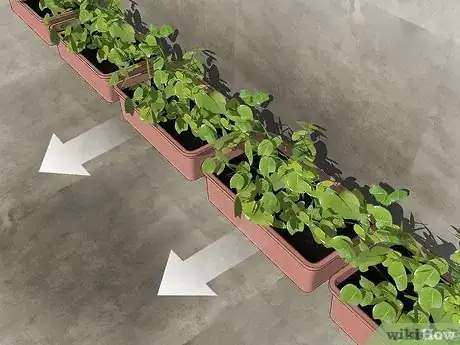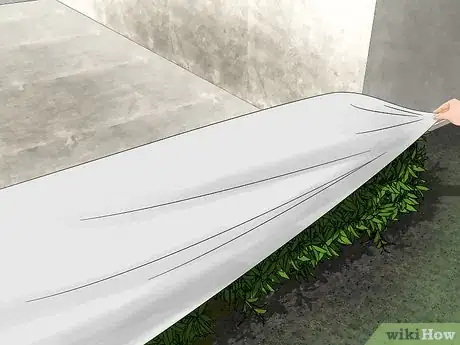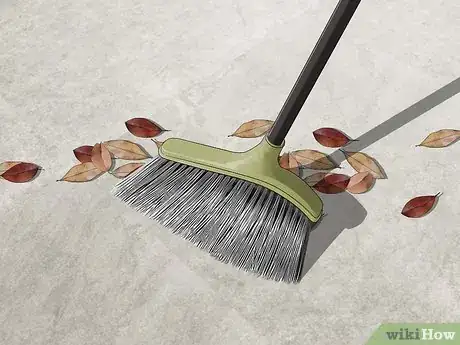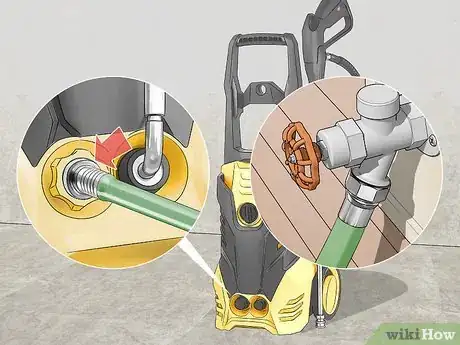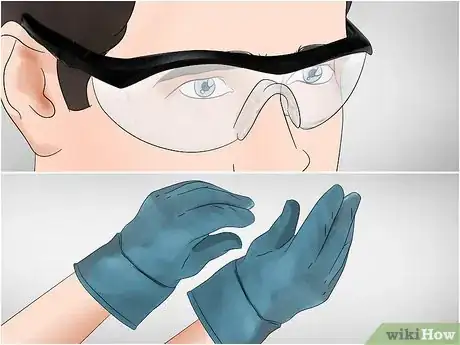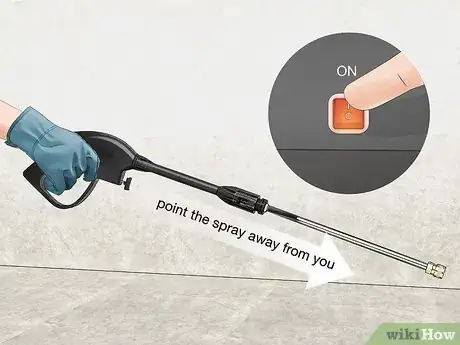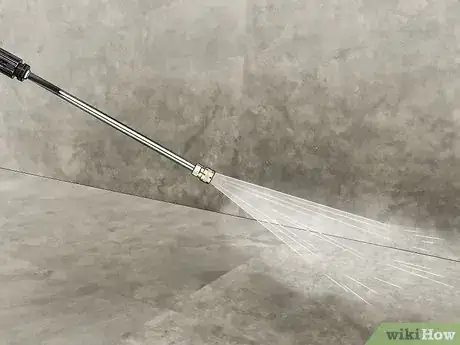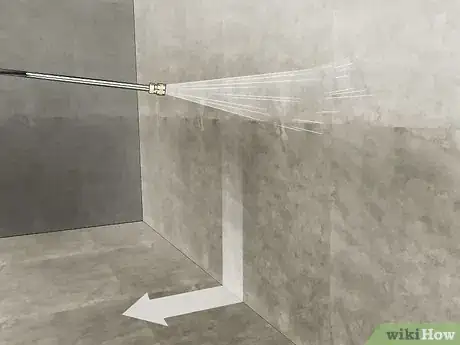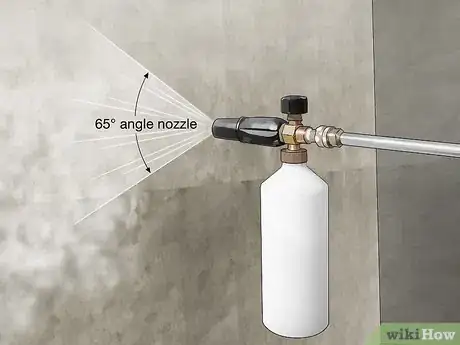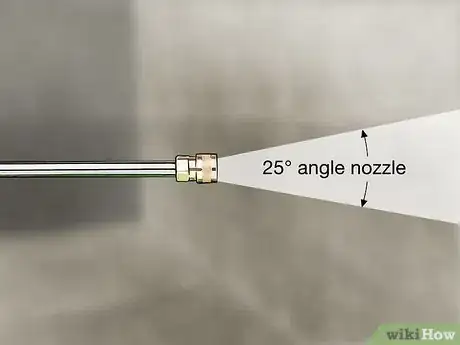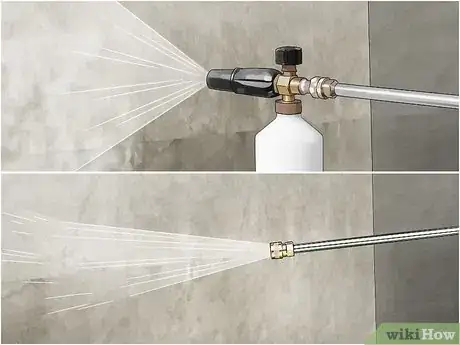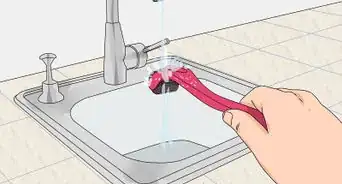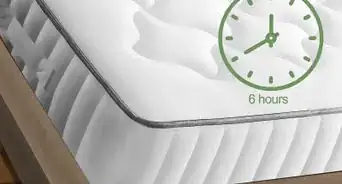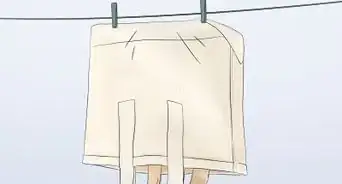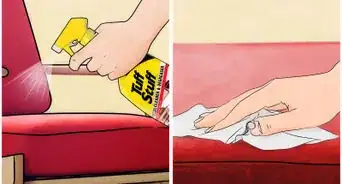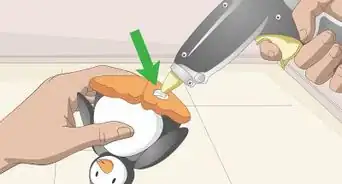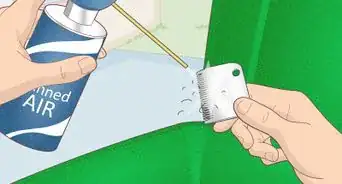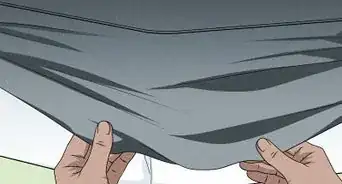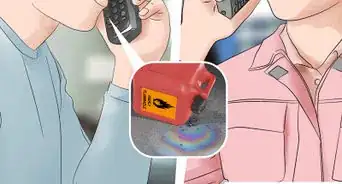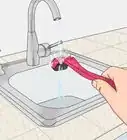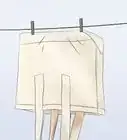This article was co-authored by Grant Wallace. Grant Wallace is a Landscaper and Owner of Grantlanta Lawn in Atlanta, Georgia. With over seven years of experience, he specializes in lawn maintenance and landscape installation. In 2012, he earned his BA from the University of West Georgia. Grant has been profiled in Shoutout Atlanta, Canvas Rebel, and Voyage ATL.
There are 14 references cited in this article, which can be found at the bottom of the page.
This article has been viewed 101,493 times.
Cleaning concrete at least once a year helps preserve its appearance and extend its lifespan. A pressure washer is the ideal tool to make short work of tough stains. While operating one may seem intimidating, pressure washers are pretty easy to use as long as you take proper safety precautions. Make use of a suitable concrete detergent and spray nozzles to clean efficiently without damaging the concrete. The key to using a pressure washer is sweeping the nozzle in a gradual, consistent pattern. By using the proper technique, you can make a concrete surface look almost new again.
Steps
Clearing the Concrete
-
1Remove vehicles and other objects you wish to protect. This includes furniture, toys, potted plants, and anything else you are able to move. These items will get in the way of the cleaning. You’re going to have a hose trailing after you, so don’t leave behind anything it could get tangled on. The force used, along with the soap used, could also damage anything left in the pressure washer’s path.[1]
- If you can’t move something, you may wish to cover it up to protect it. One way to do this is by using painter’s tape to hang plastic sheets.
- Cover outlets, walls, and doorways with plastic and tape if you suspect they could sustain damage during the cleaning process.
-
2Cover nearby plants with a drop cloth to protect them from damage. A lot of the soap and sealing products used in pressure washing can be toxic to plants, especially in an undiluted form. At the very least, soak the plants with water from a hose to help dilute the chemicals. Then, drape the cloth over any plants within range. Since you can’t really do this for grass, make sure it is damp before operating the pressure washer.[2]
- Although cleaning products harm grass, you can’t avoid getting some of it on your lawn. Dampening it reduces potential damage. For additional protection, rinse it off when you’re done using the pressure washer.
- Look for tarps and drop cloths online or at your local home improvement store. While you’re there, you can also pick up everything else you may need to complete the cleaning.
- Note that tarps and drop cloths can harm plants if left in place for too long. Remove them as soon as you’re done cleaning, particularly on warm days.
Advertisement -
3Sweep away leaves and other debris with a broom. Sweep the entire patch of concrete to eliminate obstacles like pebbles and tree branches. If you’re working on a big stretch of concrete, this can take a while. Switch to a leaf blower to speed up the process. Take your time with it and make sure you remove as much debris as you can.[3]
- Debris gets in the way and makes the pressure washer less effective. You may wish to sweep the concrete several times to ensure you get everything.
- Another way to remove debris is with a pressure washer. Spray down the concrete to push the debris off of it. It’s effective, but it uses a lot of water.
Assembling the Pressure Washer
-
1Select a washer with a pressure rating of at least 3,000 PSI. Pressure washers come in all sorts of different pressure ratings, While you can clean concrete with a lower-rated washer, it takes much longer. Try getting one with not just a 3,000 PSI rating, but also a flow rate of at least 4 US gal (15 L) of water per minute. At these settings, pressure washers are more than capable of blowing away debris without damaging concrete.[4]
- Pressure washers come in electric and gas-powered models. The top electric ones max out at about 3,100 PSI, which is perfect for washing concrete. They are also quieter than gas-powered ones.
-
2Attach the spray arm and a soaping nozzle to the pressure washer. The pressure washer comes with a metal rod that you hold onto to direct the spray of water. Detach it from the holster near the handlebar at the top of the pressure washer. It should have a black cable attached to it that also plugs into the side of the washer’s water tank. The spray arm will have an opening on its opposite end. Pull back the metal ring on the end, then plug a spray nozzle into it.[5]
- You have a couple of nozzle options when using a pressure washer. Start with a soaping nozzle or a 65-degree spray nozzle. These nozzles spread soap in a wide, gentle arc.
- You could also get a 5-in-1 nozzle. It’s an inexpensive attachment that has different spray settings, including a soap dispenser option.
-
3Connect the pressure washer to a spigot with a hose. Locate the nearest water spigot outside of your home. Attach the hose, then bring its opposite end to the inlet valve on the back of the pressure washer’s tank. Twist the adapters on the ends of the hose clockwise to finish attaching it. Make sure these connections are tight and watch for any leaks that appear after you turn on the water.[6]
- If you notice leaks, turn off the pressure washer right away and tighten the connections.
-
4Put on safety glasses, gloves, and hearing protection before operating the washer. Pressurized water can cut through bare skin, not just concrete. Expect potential splashback as well from pretty harsh concrete cleaners. Many washers, particularly gas-powered ones, also make a lot of noise. Wear earmuffs or earplugs to block out the noise.[7]
- Put on long pants and a solid pair of shoes before using the washer.
- Keep other people and pets out of the area until you’re finished. When you’re done, put the washer away so kids can’t activate it.
-
5Squeeze the handle for 30 seconds to let air out of the washer. Don’t turn the washer on right away. After connecting the hose, rotate the spigot valve clockwise to start the flow of water. Then, hold the pressure washer’s trigger down until you see a steady stream of water coming through it.[8]
- Doing this prepares the washer for use. It enables you to get the consistent stream of pressurized water necessary for efficient cleaning.
-
6Turn on the pressure washer by activating the switch near the tank. Plug the pressure washer into a nearby outlet, then hold the spray arm out in front of you. Turn on the spigot if you haven’t already to start the flow of water. While pointing the spray arm away from you, flip the switch to the on position. The pressure washer will begin spraying a concentrated burst of water as soon as you press the trigger on the spray arm.[9]
- Some pressure washers have a starter string similar to the kind you might see on a lawnmower. Pull the string away from the washer to start it.
- Be careful when activating the washer. It can surprise if you’re holding the trigger down by accident. Wait to press the trigger until you’re ready to use it so it doesn’t cause damage.
-
7Test the pressure washer on a small, inconspicuous area. Pressure washers can be damaging if they aren’t used correctly. To avoid this, start the water flow at the spigot and by turning on the pressure washer. Try spraying a concrete detergent on the area. Then, swap out the soaping nozzle for a 25-degree nozzle and rinse off the detergent.[10]
- For example, try the pressure washer out on the edge of your driveway. Pick a spot on the side that people aren’t likely to look at.
- Practice with the kind of detergent you plan on using for the entire concrete, such as a commercial degreaser. Switch to a different product if you notice discolorations.
- To make adjustments, you can turn off the washer and try something like a 45-degree spray nozzle. Another option is to hold the spray arm higher in the air to effectively clean concrete without damaging it.
Washing the Concrete
-
1Pretreat stains by scrubbing them with a concrete detergent. If concrete is badly stained, a blast of water won’t be enough to fix the problem areas. Try loading a concrete degreasing cleaner into a spray bottle to mist onto the stains. After letting the stains soak for at least 3 to 5 minutes, scrub them with a stiff-bristled brush or rag. You can wait to rinse off the cleaner until later.[11]
- Concrete detergents work for most stains, but you may need trisodium phosphate (TSP) for the tough ones. It is a harsh chemical that works on rust and other stubborn stains when diluted in water.
- For the safety of nearby plants and waterways, select a biodegradable cleaner. You could apply a bleach-based cleaner, but be careful to direct it away from storm drains when you rinse it off.
-
2Start at the top of the concrete and work toward the bottom. If the concrete is flat, you can start on any side. However, most concrete is sloped so that water runs toward on side. Position yourself in the center along the top part of the concrete. While you’re spraying, work from the center outward while moving down toward the opposite end.[12]
- If you’re cleaning a driveway, for example, work toward the street. That way, you don’t have to wade through water or worry about the upper part drying off before you finish cleaning it.
-
3Apply a concrete detergent across the concrete. Most pressure washers have a dispensing bin to pour the detergent onto. Make sure you’re using a detergent-spraying nozzle or a 65-degree nozzle to easily apply the detergent. When you’re ready, hold the nozzle at least 8 in (20 cm) of the ground and move it back and forth across the concrete. Cover the concrete in a consistent layer of soap.[13]
- Concrete detergent can dry out quickly, so you may not be able to clean the entire surface in one go. For that reason, try splitting the concrete into 10 ft × 10 ft (3.0 m × 3.0 m) sections and clean them one at a time.
- Note that you can remove a lot of dirt without using a cleaner. If you don’t need to eliminate deep stains, you might see a difference after using water only!
- Remember to check the manufacturer’s instructions to ensure you’re using the detergent the right way. It is a strong chemical and can cause damage if it isn’t properly diluted.
-
4Switch to a 25-degree spray nozzle before washing the concrete. Shut off the pressure washer and pull off the nozzle. Most people use a 25-degree spray nozzle for basic cleaning. It concentrates the spray into a relatively small but powerful stream. If you need to, you can switch to a different nozzle to take care of tough stains.[14]
- For example, try using a 15-degree nozzle for a more direct blast that can flush out mildew and other problems.
- You could also get a surface cleaner attachment. It is a device you pull along the concrete like a float. It sprays a safer and more consistent stream of water.
-
5Rinse away the detergent by sweeping the washer back and forth. Stand at the top of the concrete with the spray arm held out ahead of you. Keep the nozzle about 18 in (46 cm) above the concrete. The nozzle sprays out a fan of water about 12 in (30 cm) in size, although this will vary depending on how you hold the spray arm. Sweep the arm from side to side along the concrete by moving it at all times.[15]
- When cleaning out an area, overlap your strokes a little bit to ensure you reach all of the detergent. It doesn’t matter how much they overlap, but keep the sprayer moving to avoid damaging the concrete.
- Direct the soap to the sides of the concrete and to your lawn. Don’t wash detergent toward storm drains, since this may be against the law in your area.
-
6Repeat soaping and spraying until the concrete is completely clean. Switch back to a soap-spraying nozzle to apply more detergent as needed. Then, swap out nozzles or use a surface cleaner to wash away the new batch of soap. You may have to do this several times to finish cleaning a large patch of concrete. When you’re done, check over the concrete for any stains that remain.[16]
- If you still see stains, spot treat them with an appropriate cleaner, then use the pressure washer again. Sometimes it can take a few tries, but most concrete comes clean right away.
Community Q&A
-
QuestionIf we sealed the concrete, would that extend the cleaning requirement for a longer period of time?
 Community AnswerAbsolutely. That's one main reason for sealing and it works quite well, but does have to be re-applied every 3-5 years.
Community AnswerAbsolutely. That's one main reason for sealing and it works quite well, but does have to be re-applied every 3-5 years. -
QuestionWhat is the best way to remove oil/petrol from tarmac?
 Community AnswerThe chemical compound tri-sodium phosphate (TSP) removes dense areas of oil or grease from concrete surfaces.
Community AnswerThe chemical compound tri-sodium phosphate (TSP) removes dense areas of oil or grease from concrete surfaces. -
QuestionWhich tip works best to clean concrete and what color is it?
 Ron LobleyCommunity AnswerA Green 15° or a long Black 'Turbo Tip'. That has the same high pressure nozzle that the Red 0° High-Pressure has, but the Turbo one rotates around and creates about a 3 inch circle of complete high pressure removing power.
Ron LobleyCommunity AnswerA Green 15° or a long Black 'Turbo Tip'. That has the same high pressure nozzle that the Red 0° High-Pressure has, but the Turbo one rotates around and creates about a 3 inch circle of complete high pressure removing power.
Warnings
- Take necessary safety precautions when using a pressure washer and strong chemicals. This includes wearing safety glasses, hearing protection, long-sleeved pants, and shoes.⧼thumbs_response⧽
- Many areas have rules governing how to dispose of cleaning chemicals. In most cases, you can’t flush chemicals down a storm drain and instead have to wash them onto your lawn.⧼thumbs_response⧽
Things You’ll Need
- Pressure washer
- Concrete detergent
- Stiff scrub brush
- Hose
- Water
- 25-degree spray nozzle
- Soap dispensing nozzle
- Gloves
- Safety glasses
- Earplugs or earmuffs
References
- ↑ https://www.youtube.com/watch?v=mE3QjYnMdt4&feature=youtu.be&t=49
- ↑ https://www.youtube.com/watch?v=Y_foQ0gfkRo&feature=youtu.be&t=219
- ↑ https://www.rocklin.ca.us/sites/main/files/file-attachments/pressure_washing__0.pdf
- ↑ https://www.popularmechanics.com/home/how-to/a9413/everything-you-need-to-know-about-pressure-washers-15826265/
- ↑ https://www.youtube.com/watch?v=MYTyEP0KCLY&feature=youtu.be&t=78
- ↑ https://www.youtube.com/watch?v=bt1tywvQh9s&feature=youtu.be&t=177
- ↑ https://www.bobvila.com/articles/how-to-clean-concrete/
- ↑ https://www.bobvila.com/articles/the-dos-and-donts-of-pressure-washing/
- ↑ https://www.youtube.com/watch?v=4hC7sLvlLkw&feature=youtu.be&t=33
- ↑ https://www.popularmechanics.com/home/how-to/a9413/everything-you-need-to-know-about-pressure-washers-15826265/
- ↑ https://www.bobvila.com/articles/how-to-clean-concrete/
- ↑ https://www.youtube.com/watch?v=rP0SJgzDhFw&feature=youtu.be&t=52
- ↑ https://www.youtube.com/watch?v=d9uulq_mj5U&feature=youtu.be&t=479
- ↑ https://www.youtube.com/watch?v=mE3QjYnMdt4&feature=youtu.be&t=152
- ↑ https://www.youtube.com/watch?v=qtYrUdN-4Qw&feature=youtu.be&t=517
- ↑ https://www.youtube.com/watch?v=cy_S8ovFomQ&feature=youtu.be&t=65
- ↑ https://www.bobvila.com/articles/how-to-clean-concrete/
About This Article
Pressure washing concrete once a year is a great way to increase its lifespan and make it look as good as new. Try to select a washer with a rating of at least 3,000 PSI so it has enough power to clean the concrete surface. Once your washer is assembled, put on glasses, gloves, and hearing protection for your safety. Test the pressure washer on an inconspicuous piece of concrete to make sure it's not going to cause discoloration or damage. If it does, try holding the pressure washer further away from the concrete or switching to another detergent. Start the cleaning process by spraying detergent onto a 10 foot by 10 foot square of your driveway. Then, clean off the detergent with a blast of water before moving onto the next square. That way, you can clean the concrete without the detergent drying out. If you’re dealing with tough stains that water can't remove, apply a concrete decleanser using a spray bottle. Leave it to sit for 3 to 5 minutes, then scrub the area with a stiff-bristled brush. For tips on how to assemble a pressure washer, keep reading!
